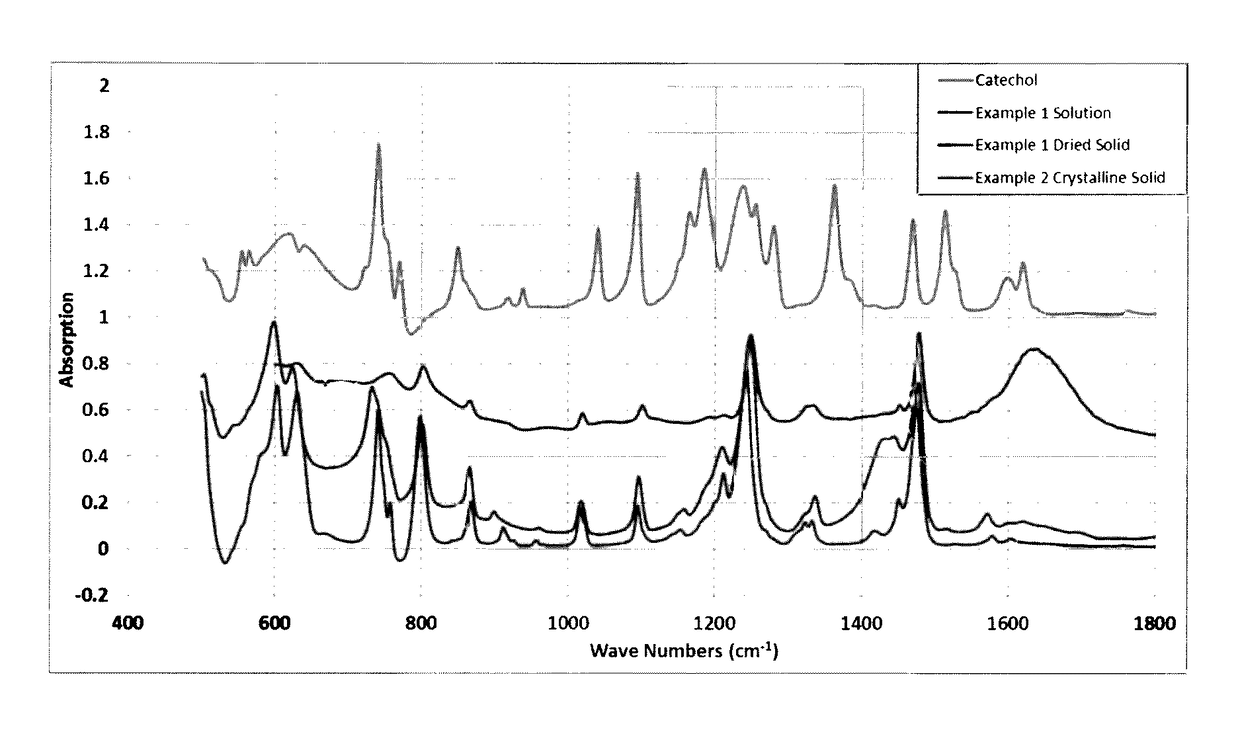Hydrothermal treatment method for producing redox-active transition metal coordination compounds
a transition metal and coordination compound technology, applied in the direction of aqueous electrolyte fuel cells, indirect fuel cells, electrochemical generators, etc., can solve the problems of high reactive precursor materials, high cost, and add significant cost to the commercial production process, and achieve the effect of low cost and more economical
- Summary
- Abstract
- Description
- Claims
- Application Information
AI Technical Summary
Benefits of technology
Problems solved by technology
Method used
Image
Examples
example 1
on of Titanium Catechol Complex, Sodium Salt
[0031]208.1 g catechol (Alfa Aesar) was dissolved in 800 g deionized water, to which 120 g of NaOH solution containing 50.1 g NaOH and 58.8 g of a TiO2 product containing 50 g TiO2 (the product contained 85% TiO2 with the rest being water) were added consecutively. After a short mixing period of from 3 to 5 minutes the mixture was transferred to a two-liter hydrothermal reactor, and the reaction mixture was treated, i.e., raised to a temperature of 120° C. and held at that temperature for 16 hours. Thereafter, the hydrothermal reactor was cooled to room temperature or ambient temperature, and a dark brown, clear solution was obtained. The TiO2 was completely dissolved during the treatment period, due to the formation of the soluble catechol complex. Chemical analysis showed the solution contained about 22 wt % of the titanium catechol complex compound. The major FT-IR bands of the solution and an oven dried sample of the solution matched t...
example 2
on of Titanium Catechol Complex, Ammonium Salt
[0032]The same procedure was followed as in Example 1 except that the NaOH solution was replaced with 72.5 g of an ammonia solution (containing 29 wt % NH3). After hydrothermal treatment, the reaction mixture was transferred to a beaker and stored in a refrigerator overnight for crystallization. Crystals that were formed were separated by filtration. FT-IR spectrum of the sample showed absorption bands in agreement with that of the ammonium salt of titanium catechol complex published in the literature.
example 3
on of Titanium Pyrogallol Complex, Ammonium Salt
[0033]The same procedure was followed as in Example 2 except that an equivalent amount of pyrogallol was used in place of catechol. Hydrothermal treatment of the reaction mixture resulted in a clear, dark brown solution similar to the titanium catechol complex. The ammonium salt of the titanium pyrogallol complex that was formed showed higher solubility in water than the corresponding catechol complex. The solution didn't crystallize even after being stored in a refrigerator overnight. A solid sample was obtained by vacuum evaporation.
PUM
| Property | Measurement | Unit |
|---|---|---|
| temperature | aaaaa | aaaaa |
| temperature | aaaaa | aaaaa |
| chemical energy | aaaaa | aaaaa |
Abstract
Description
Claims
Application Information
 Login to View More
Login to View More - R&D
- Intellectual Property
- Life Sciences
- Materials
- Tech Scout
- Unparalleled Data Quality
- Higher Quality Content
- 60% Fewer Hallucinations
Browse by: Latest US Patents, China's latest patents, Technical Efficacy Thesaurus, Application Domain, Technology Topic, Popular Technical Reports.
© 2025 PatSnap. All rights reserved.Legal|Privacy policy|Modern Slavery Act Transparency Statement|Sitemap|About US| Contact US: help@patsnap.com

